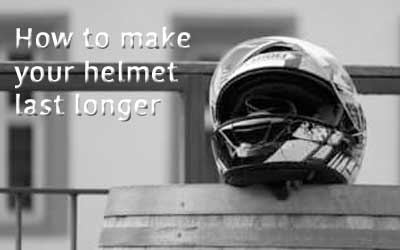Do you ever get annoyed by how loud your motorcycle helmet can get while riding? This seemed to bother me and many other riders so I decided to do some research on how to reduce the noise level.
How do you reduce motorcycle helmet noise? Here are a few ideas that can help keep your helmet quiet so you don’t lose your hearing:
- Wear a properly fitted helmet
- Wear helmet earmuffs
- Wear earplugs
- Wear a scarf
- Use a wind blocker
- Stuff your helmet with fleece
- Reduce turbulence by removing accessories
- Adjust your windscreen
- Fill your ear holes with memory foam
- Wear a balaclava
- Wear a face mask
- Close your helmet visor
- Buy a quiet helmet
The rest of this article will cover these helmet soundproofing tips in more detail. Of course, it won’t be 100% quiet but you should notice a considerable reduction in noise. Try implementing a few different tips to compare their effectiveness as some may work better for you than others.
Tip #1 – Make Sure Your Helmet Fits Correctly
Not only is the correct sized helmet important to keep you safe during a crash but it also helps to protect you from wind noise. This alone can reduce the amount of wind noise resonating through the helmet.
The shape and size of your helmet must fit your head properly, especially around your neck. Read my post on how to measure your head in order to make sure you buy the correct sized helmet.
Tip #2 – Quiet Ride Ear Muffs
If you live in a colder climate, purchasing ear muffs for a motorcycle helmet is a good idea to keep your ears warm and protect them from wind noise. I found this website quietridemuffs.com that actually has ear muffs you can buy to wear inside your helmet.
Tip #3 – Plug Your Ears
One of the most popular and convenient ways to deal with wind noise is to purchase some ear plugs. These are a quick and effective way to protect your ears from harmful noise levels.
They are comfortable to wear with your helmet and fit most ear sizes. The silicone does a great job of absorbing sound and includes an aluminum carrying case for storage and transport.
Tip #4 – Wear a Scarf
Turbulence creates wind noise. This can enter your helmet from underneath your chin through any openings where your helmet meets your neck.
One way to block the wind is by wearing a scarf around your neck. You want to wear it high enough so it meets the bottom of your helmet, which creates a shield to prevent the wind from traveling through your helmet.
Tip #5 – Wear A Wind Blocker
Since a lot of wind can enter your helmet from underneath, it is important to purchase a helmet that has significant padding in the neck area. If your helmet does not have this feature or is lacking it, try using one of these padded helmet supports.
These supports will help seal any open space underneath your helmet to reduce turbulence noise. It will also provide additional comfort and neck support. Check out the NOJ Quiet Rider, which is recommended by many riders. It is a lightweight wind blocker that reduces wind noise effectively and drafts.
If you prefer to get a helmet with a quality neck roll to protect you from wind noise, check out the Schuberth C3. This features a double neck roll that will dampen noise and provide ultimate comfort. You will be surprised by how quiet this helmet actually is!
Tip #6 – Stuff Your Helmet With Fleece
Fleece acts as a good wind blocker. Try stuffing some fleece behind the cheek pads of your helmet. This will create a tighter seal around your face and deflect the wind from rising up into your helmet.
Tip #7 – Ride A Naked Bike
A bike without any windscreens or additional accessories may cause less turbulence. You can also remove any unnecessary accessories.
Riding a “naked” bike provides a cleaner air stream, which can result in less wind noise. Any turbulence can significantly impact the back of your helmet so you want to minimize this as much as possible.
Tip #8 – Windscreen Adjustment
I know I just said to try riding a bike without a windscreen but if you do have one, they can be effective if they are the correct shape. You can adjust your windscreen so it is even more effective by buying a windscreen spoiler.
Windscreen spoilers act as an extension deflector for your motorcycle windshield. This is definitely an effective way to deflect more wind and reduce the amount of noise.
Tip #9 – Stuff Memory Foam In The Ear Holes
Similar to the fleece idea, you can stuff some memory foam into the ear pockets of your helmet. Simply cut something like this memory foam pad into a small enough dimension so it fits in your helmet.
Before you put your helmet on, squeeze the foam tight with your hands up against your ears while you quickly slide it on. The foam will expand and cover your ears.
Tip #10 – Wear a Balaclava under your helmet
Wearing a balaclava will help to reduce wind noise while wearing your helmet. It is especially helpful in keeping you warm if you live in a cold climate.
Tip #11 – Wear A Face Mask
This tip is similar to wearing a scarf. Wearing a motorcycle face mask while riding will certainly make difference. Not only will it protect you from bugs, dust, and debris, it will also help reflect the amount of wind entering up underneath your helmet. This will act like a chin skirt to protect you.
Tip #12 – Ride With Your Visor Closed
Any opening in your helmet while riding will significantly enhance wind noise. Therefore, make sure you ride with your visor closed and securely sealed all the way around your face. If it is not sealed properly or can’t seal all the way, it will create unnecessary turbulence and noise.
Tip #13 – Buy A Quiet Motorcycle helmet
One of the best things you can do in order to reduce motorcycle helmet noise is to buy a quiet motorcycle helmet. There are certain features to look for that will help to give you that silent ride you are seeking.
Type of Helmet
What type of helmet are you buying? This should be one of the first questions you ask yourself. Open-faced helmets will produce the most noise because they have the largest opening for the wind to enter. So anything that is half or three-quarter covered will generate a high level of wind noise. I suggest going with a full-face helmet to block the wind.
Aerodynamics
Aerodynamics is extremely important when it comes to sound reduction. You want a helmet that creates the least amount of friction as possible. Anything extending outward from your helmet will produce extra wind noise.
You want a helmet that is sleek and smooth so wind easily glides over your head. This will create a quieter headspace. The Schuberth helmet mentioned earlier in this article is a helmet that features an excellent aerodynamic design making it one of the quietest motorcycle helmets on the market.
How many Vents?
If there are multiple vents in your helmet, that means more ways for air to enter. The number of vents and position vary greatly by the helmet. Typically full-face helmets have fewer vents.
There is no way to avoid vents because you need some type of airflow to remain cool while riding. Therefore make sure to get a helmet that has a quieter ventilation system if possible.
What Is Wind Noise?
This is the noise that the wind creates when it comes in contact with a solid surface. Once the wind hits an object, it creates a vibration that can be detected by our ears.
Typically when you ride a motorcycle you travel at high speeds, which creates a strong wind force that hits your helmet. This results in a loud noise that can damage your eardrums.
You may experience a “booming” noise while riding. This is usually the cause of turbulence under the lower region of your helmet.
How Can Wind Noise Damage Your Hearing?
Wind noise is surprisingly loud. So loud in fact that it can truly harm your hearing in the long run. Riding at speeds over 65 mph increases the volume of noise significantly to dangerous levels of 100 dB or more.
Being exposed to this type of wind noise over a long period of time may damage your hearing. Some side effects of consistent wind noise can result in permanent loss of hearing, tinnitus, or fatigue.
Motorcycle engine vibration is another harmful source of sound being transmitted through your body. This noise vibration is difficult to prevent because it resonates through your bones into your ears.
What to expect?
Implementing the precautions mentioned in this article to mitigate sound will only reduce wind noise to a certain degree. The most important takeaway is that your helmet fits properly. This will solve a lot of noise issues immediately.
Also, an individual’s tolerance of noise will vary greatly among others. Therefore it’s difficult to fully describe what one is experiencing. However, wind noise does exist and it can be bothersome and harmful to your overall hearing health.



